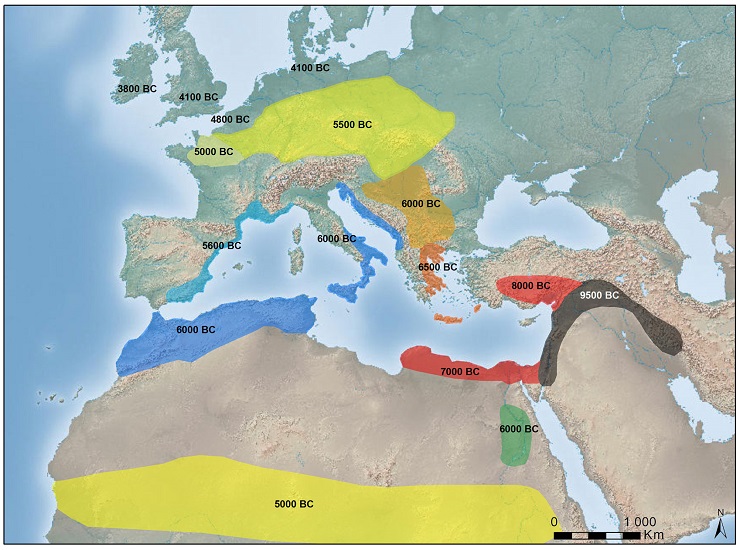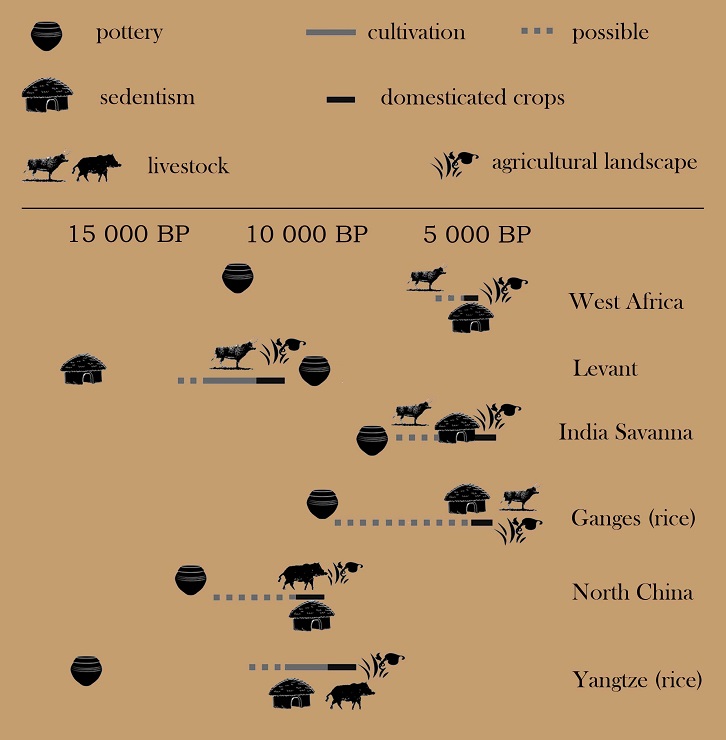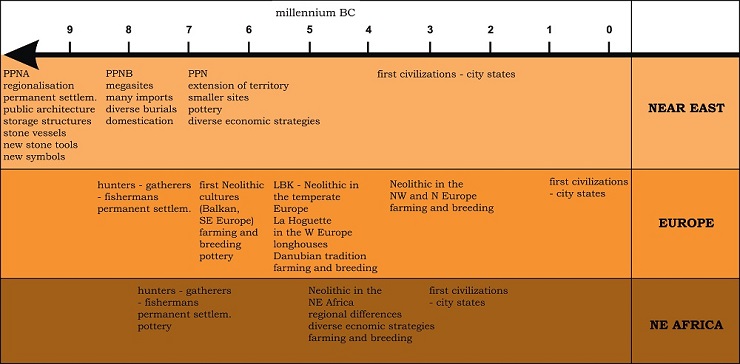|
|
| On the different continents the Neolithisation process took place based on a different sequence of the individual items that comprised the Neolithic package, as is demonstrated in this image by D. Q. Fuller (modified). |
When exploring the Neolithic period Contemporary Archaeology has to take notice of the results of various individual social and natural science disciplines even while, at the same time, it is also struggling to deal with its own sources - the remains of material culture that are available to it in different parts of the world in varying quantities and quality. Currently there are dozens or hundreds more people involved in working on Neolithic topics. At this moment in time, however, let us to reduce the large number of issues to a few of the fundamental ones - i.e. based on the cardinal and the provocative questions - why, how, where, when and in which manner.
|
|
| The fundamental changes to the arrangement of the settlements and the introduction of “innovation” that was associated with neolithisation cannot be time-delimited simply. |
Despite all the previous attempts to explain the adaptation of the human species to agricultural subsistence through evolution and by the pressure of the natural environment the questions about why and how neolithisation actually took place, belong more to the realm of philosophy. The modern multidisciplinary approach to archaeology does, however, offer a variety of different models in regard to where it happened, more-or-less when it started and particularly the manner in which it then spread.
Most frequently the neolithisation process is represented in the literature as a Neolithic package. This basically comprises change - innovation that occurred gradually, simultaneously or in a variety of differing combinations - which sooner or later led (not always and not everywhere) to a more settled way of life and to agricultural subsistence – i.e. plant cultivation and animal husbandry. The Neolithic package is also associated with the production of specific and specialised stone tools.
 |
| The spatial extent of the area in which the earliest documentation of neolithisation took place varies in accordance with each individual professional publication - is even the shape and the dimensions of the Fertile Crescent (marked here in black) are quite variable. From time-to-time Neolithisation models are challenged and rejected - to some of them we are coming back later, however. The figure shows that to the SW and the NW of the Fertile Crescent the age of the areas of neolithisation decreases. |
The transition from the hunter-gatherer manner of achieving sustenance to agricultural production and the other features of the Neolithic package subsequently spread to different parts of the world in a variable time sequence. The most important area in regard to our work is the Near East dating back to the period around the mid-10th millennium BC. In Europe radiocarbon data defined the first Neolithic sites located in the Balkans and along the Mediterranean Sea during the 7th millennium BC, while here, in the heart of Europe, there is evidence dating back to before the middle of the 6th thousand BC, while neolithisation had not reached the northwest of the European territory until the end of the 5th thousand BC.
What was the cause, or were the causes of the neolithisation process - meaning the creation and the subsequent spreading of the Neolithic way of life? Which happened first? Was it climate change or changes in thinking and to the social fabric of the society? Why did neolithisation not occur sooner, during the hot and humid interglacial period between the Ice Ages? Was it a population explosion that was behind the spread of the Neolithic, or was it innovative thinking – discovering an easier manner of subsistence or a new and more interesting social system – or was it a new religion? Based on our current knowledge all of the answers to these questions referred to here are questionable and for each group of supporters of this or that theory, there is another group of equally zealous opponents. The causes and the consequences of the origins of the Neolithic and of the subsequent neolithisation were probably different in different parts of the world. Plant and animal domestication took place in several different foci, which also manifested in three of the areas that interest us; these comprise the Near East, Central Europe and North-eastern Africa.
Want to learn more?
- Akkermans, P. M. M. G. – Schwartz, G. M. 2003: The Archaeology of Syria: From Complex Hunter-Gatherers to Early Urban Societies (ca. 16.000 - 300 BC). Cambridge: Cambridge University Press.
- Barker, G. 2006: The Agricultural Revolution in Prehistory: Why did Foragers become Farmers? Oxford: Oxford University Press.
- Bouzek, J. – Buchvaldek, M. – Kostomitsopoulos, P. – Sklenář, K. 1983: Dějiny archeologie I. Praha: Univerzita Karlova v Praze, 126-128.
- Cauvin, J. 2000: The Birth of the Gods and the Origins of Agriculture. Cambridge: CNRS editions and Cambridge University Press.
- Dittrich, A. 2011: Zur Neolithisierung des Mittleren Niltals und angrenzender Regionen. Kultureller Wandel vom Mesolithikum zum Neolithikum im Nord- und Zentralsudan. BAR International Series 2281. Oxford: Archaeopress.
- Douglas Price, T. ed. 2000: Europe´s First Farmers. New York: Cambridge University Press.
- Evershed, R. P. – Payne, S. – Sherratt, A. G. – Copley, M. S. – Coolidge, J. – Urem-Kotsu, D. – Kotsakis, K. - Özdoğan, M. - Özdoğan, A. E. – Nieuwenhuyse, O. – Akkermans, P. M. M. G. – Bailey, D. – Andeescu, R. R. – Cambell, S. – Farid, S. – Hodder, I. – Yalman, N. – Özbaşaran, M. – Bıçakçı, E. – Garfinkel, Y. – Levy, T. – Burton, M. M. 2008: Earliest date for milk use in the Near East and southeastern Europe linked to cattle herding. Nature 455 (7212), doi: 10.1038/nature07180. Epub 2008 Aug 6., 528-531.
- Fagan, B. M. 1992: People of the Earth: An Introduction to World Prehistory. New York: The Lindbriar Corporation.
- Fuller, D. Q., G. Willcox, and R. G. Allaby. 2011. Cultivation and domestication had multiple origins: arguments against the core area hypothesis for the origins of agriculture in the Near East. World Archaeology 43 (4): 628–652.
- Hodder, I. 1990: The Domestication of Europe. Oxford and Cambridge: Basil Blackwell.
- Molleson, T. 1994: The Eloquent Bones of Abu Hureyra. Scientific American 271/2, 70-75.
- Renfrew, C. – Bahn, P. eds. 2014: The Cambridge World Prehistory. Volume 1: Africa, South and Southeast Asia and the Pacific. Cambridge University Press.
- Teegen, W. R. – Kreutz, K. – Kunter, M. 2003: Neue paläopathologische Beobachtungen an Skeletten aus dem mittelneolithischen Gräberfeldt von Trebur (Ldkr. Gross-gerau) – ein Vorbericht. Beiträge zur Archäozoologische und Prähistorische Anthropologie IV, 46-50.
- Whittle, A. 1996: Europe in the Neolithic: The creation of new worlds. Cambridge: Cambridge University Press.
- Whittle, A. – Cummings, V. eds. 2007: Going over – The Mesolithic-Neolithic Transition in North-West Europe. Proceedings of the British academy 144. Oxford/New York: The British Academy/Oxford University Press.
 Archeologické 3D virtuální muzeum
Archeologické 3D virtuální muzeum

.jpg)

